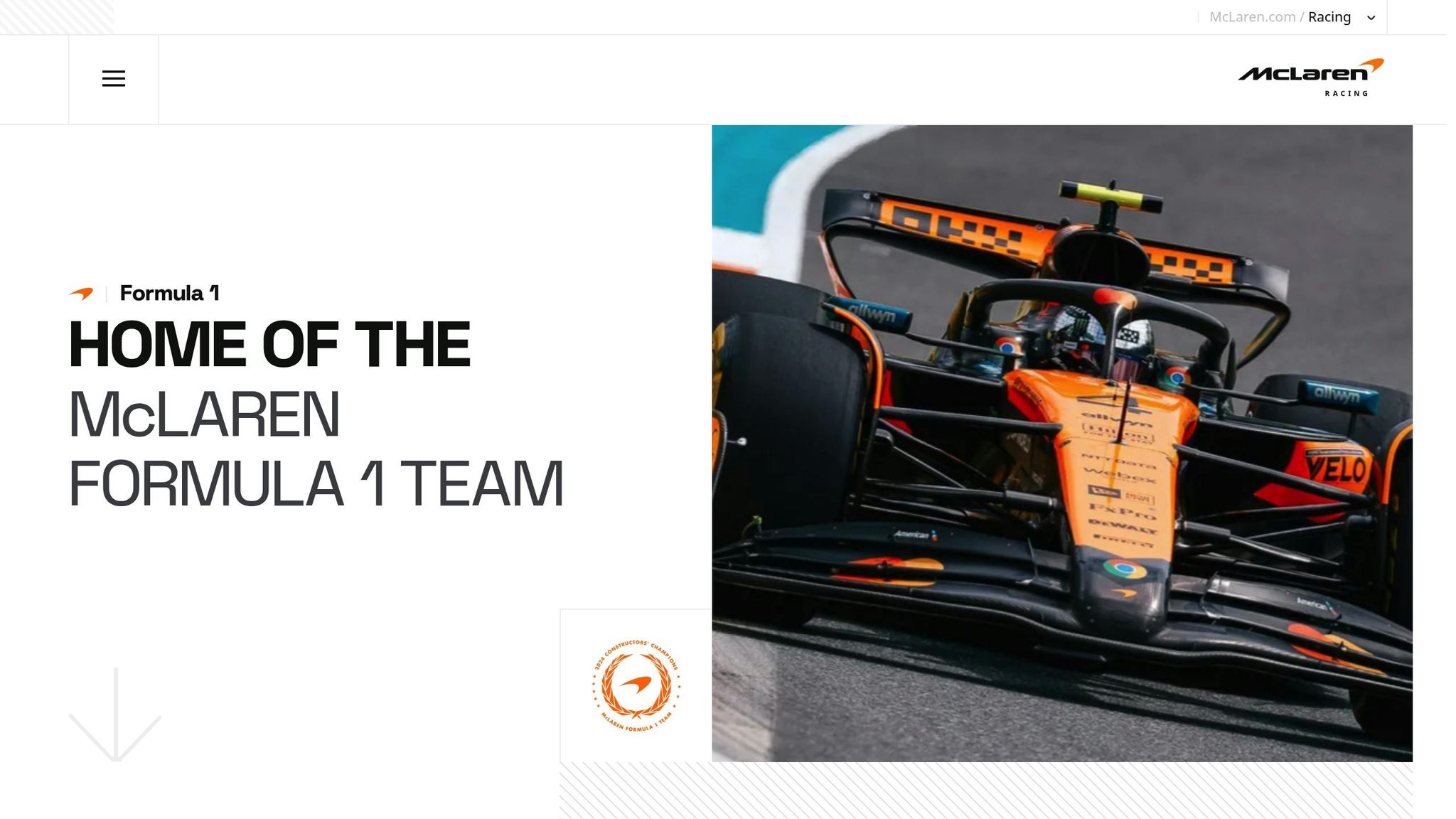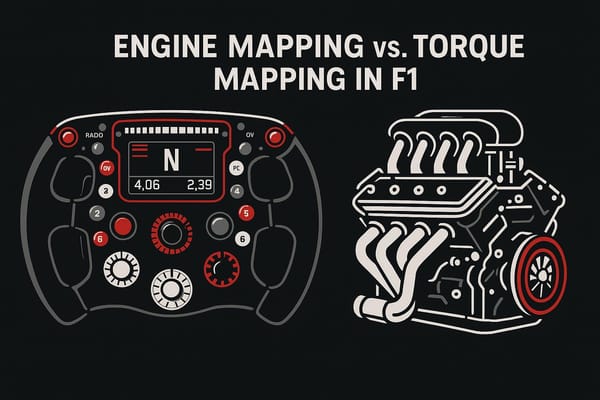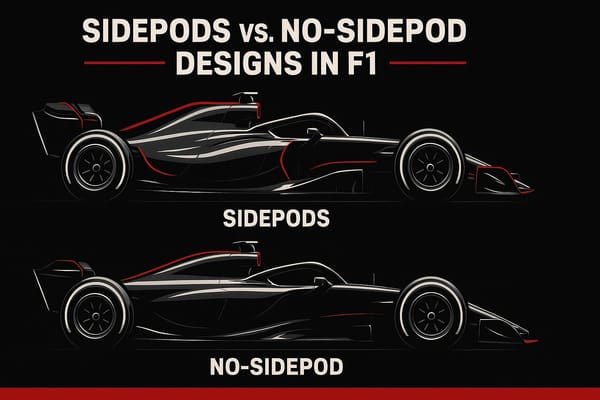Suzuka Returns: Key Battles to Watch at the 2025 Japanese Grand Prix
The 2025 Japanese Grand Prix at Suzuka highlighted fierce team rivalries, emerging talent, and the impact of weather on race strategies.

The 2025 Japanese Grand Prix at Suzuka delivered intense rivalries, standout performances, and high-stakes drama. Here's what stood out:
- McLaren vs. Red Bull: McLaren leads the Constructors' Championship, but Red Bull's Max Verstappen secured his fourth consecutive Suzuka win, showcasing his mastery of the circuit.
- Mercedes vs. Ferrari: Mercedes displayed consistent pace, while Ferrari struggled with car balance and tire management, despite some progress.
- Rising Stars: Andrea Kimi Antonelli became the youngest driver to lead a race and set the fastest lap, while Yuki Tsunoda made his home debut for Red Bull, energizing the Japanese crowd.
- Suzuka's Challenges: The circuit's technical layout, resurfaced asphalt, and unpredictable weather tested drivers and teams alike, with qualifying proving critical.
Suzuka remains a cornerstone of Formula 1, blending driver skill, team strategy, and car performance into a thrilling spectacle.
2025 F1 Japanese GP Race by Peter Windsor
1. McLaren vs. Red Bull

McLaren currently leads the Constructors' Championship with 460 points, pulling ahead of Red Bull. In the Drivers' standings, Oscar Piastri holds the top spot with 234 points, closely followed by his teammate Lando Norris at 226 points. Meanwhile, Max Verstappen sits at 165 points - Red Bull's lowest total after 12 races since 2015.
Performance Trends
McLaren's success can be attributed to their ability to manage rear tires effectively and perform well in medium-speed corners. The MCL39 thrives in simulations but still falls short in raw top speed when compared to competitors like Red Bull and Ferrari. On the other hand, Red Bull's RB21, while generally strong, struggles in low-speed corners and with mechanical grip. Verstappen himself noted:
"We were lacking quite a bit in Sector 2, all the low-speed, mechanical grip corners, where the track also drops away from you, where you have to ride kerbs… that's where we struggle the most, unfortunately, and that never really seemed to improve a lot."
Despite these challenges, Verstappen managed to secure pole position at the British Grand Prix, showcasing his skill and the car's potential. These performance differences will play a significant role as the teams head to Suzuka.
Track-Specific Strengths
Suzuka's freshly laid asphalt has reduced tire degradation, which aligns well with McLaren's strength in tire management. McLaren Team Principal Andrea Stella commented:
"With the new (asphalt), Suzuka has changed from being a high-degradation circuit (and) is now a very low-degradation circuit."
Red Bull, however, retains an edge in Suzuka's low-speed sections, particularly around the final chicane - a spot where Verstappen has historically excelled in defending his position. The circuit itself is a mix of 18 corners with varying speeds, reaching top speeds of about 195 mph and averaging around 143 mph.
Historical Suzuka Data
Past races at Suzuka emphasize how small margins can determine the outcome. Verstappen's recent performances at the circuit include narrow victories, such as his 2025 win by just 1.423 seconds. Qualifying has also been incredibly tight, with only a 0.044-second gap separating the top three on the grid in one instance.
At Suzuka, qualifying plays a critical role, as overtaking demands a significant pace advantage - around seven to eight-tenths of a second per lap. While McLaren has shifted its focus to preparing for the 2026 regulations, limiting upgrades to the MCL39, Red Bull remains committed to immediate performance gains. This dynamic keeps the championship battle highly unpredictable.
2. Mercedes vs. Ferrari

While McLaren and Red Bull are locked in a battle of tire strategies and grip, Mercedes and Ferrari are waging their own tactical war at Suzuka. Both teams entered the 2025 season with high hopes, but their journeys so far have diverged significantly.
Performance Trends
Ferrari's 2025 season has been a rollercoaster. After finishing second in the 2024 Constructors' Championship with a strong finish, the team has stumbled out of the gate this year, managing just 94 points in the first six races. The Scuderia’s struggles have been a topic of disappointment, as Jolyon Palmer pointed out.
A major issue for Ferrari has been the SF-25's balance and tire management. Team principal Fred Vasseur didn’t mince words when discussing their challenges:
"With two or three tenths of a second making the difference between fighting for the win or being down in the midfield in Formula 1 at the moment, the team will be working hard with the aim of getting more out of the car package. The SF-25 needs to be better balanced and tyre management also requires work."
In contrast, Mercedes has displayed more consistent performance. While not dominating the championship, their W16 has shown competitive pace, with Andrea Kimi Antonelli setting the fastest lap at the Japanese Grand Prix at 1:30.965. These contrasting performances have led to distinctly different strategies on race weekends.
Race Approaches
The strategies of both teams reflect their differing philosophies for 2025. Ferrari often takes a reactive stance, scrambling to find the right setup during race weekends. At Suzuka, this approach yielded some progress, but the gap to the leaders was still evident. Charles Leclerc acknowledged the improvement, while Lewis Hamilton pointed out the ongoing pace issues.
Suzuka's freshly resurfaced first sector introduced opportunities for one-stop strategies. Teams could start on medium tires and pit between laps 19 and 25 for hard compounds. While this flexibility could play to both teams’ strengths, execution is critical, especially with Suzuka’s 23-second pit stop penalty.
Track-Specific Strengths
Both teams are adapting their strategies to meet the unique demands of Suzuka. Known for its challenging layout, the track often highlights the best drivers and cars. With limited run-off areas, the risk of Safety Car periods is high, and any disruption could dramatically alter the race order.
Ferrari showed some signs of life at Suzuka, scoring 18 points - their best single-race haul so far this season. Leclerc’s fourth-place finish, while still 16 seconds off the lead, marked a step forward for a team grappling with fundamental pace issues. Leclerc summed up their struggles:
"There's just not enough performance in the car."
Vasseur echoed this sentiment after the race:
"Today's race result reflected what we saw in qualifying yesterday. With the car that we had we probably could not have done more."
Historical Suzuka Data
Suzuka’s history serves as a reminder of the competitive legacy these teams bring to the track. Ferrari boasts seven Constructors' victories at the Japanese Grand Prix, while Mercedes has six. Ferrari’s SF90 still holds the fastest recorded lap time at Suzuka with a 1:27.06. This rich history only adds to the pressure on both teams to maximize their performance.
The task ahead is clear: both teams must close the gap to the front-runners while squeezing every ounce of performance out of their current cars. As Vasseur put it:
"We need to keep the same approach. The gap doesn't matter, nor the results of today. We need to try to do a better job next week, to improve the potential and also the extraction of the potential of the car in its operation and potential."
3. Rising Stars and Home Heroes
While established team rivalries continue to dominate the headlines, the emergence of young talent is injecting new energy into Suzuka's storied history. The 2025 season has ushered in a wave of youthful drivers, led by 18-year-old Andrea Kimi Antonelli, and brought the grid's average age down to 27. This shift toward younger competitors is creating exciting narratives as the Japanese Grand Prix unfolds.
Performance Trends
Andrea Kimi Antonelli made history at Suzuka, becoming the youngest driver ever to lead a Grand Prix at just 18 years and 224 days. He also set the fastest lap of the race - 1:30.965 on lap 50 - breaking Verstappen's previous record. His P6 finish was a testament to his ability to push the limits of the Mercedes W16 under intense pressure.
Oscar Piastri, another standout among the new generation, continued to solidify his reputation as one of Formula 1's most consistent performers. The 23-year-old Australian clinched a podium spot with a P3 finish at Suzuka, extending his streak to 29 consecutive points-scoring weekends.
Suzuka also proved to be a milestone for Isack Hadjar, who scored his first-ever F1 points with a P8 finish. This achievement highlights the growing depth of talent among the sport's newcomers.
Track-Specific Strengths
Suzuka's challenging layout is a true test of skill, requiring both precision and bravery - qualities that emerging drivers must master to succeed. Antonelli’s performance demonstrated his ability to adapt to one of Formula 1's most demanding circuits. Leading the race briefly while managing tire wear and executing a solid strategy, he showed poise far beyond his years.
For Yuki Tsunoda, Suzuka represents both an opportunity and a challenge. Now racing for Red Bull Racing after a mid-season move, the 24-year-old Japanese driver faces the unique pressures of competing on home soil. Tsunoda has spoken candidly about the hurdles he’s faced transitioning to the European racing scene:
"First of all, (we are) very far away from Europe. And I think mainly you want to race in Europe in junior categories to get a Super License. And to be close as much as possible to the Formula 1 teams, to get attention."
He also touched on the language barriers that can complicate communication with his team:
"Japanese don't speak as much good English. So it's hard to communicate well, and tell what you want specifically from the car - setup, for example. These things will take a little bit of time."
These insights, paired with his on-track performance, highlight the broader impact of youth on race dynamics.
Historical Suzuka Data
Suzuka has long been a proving ground for drivers, and strong performances here often carry extra significance. The circuit’s history of crowning champions makes it a key venue for young drivers looking to make their mark.
| Driver | Age | 2025 Suzuka Result |
|---|---|---|
| Andrea Kimi Antonelli | 18 | P6 |
| Oscar Piastri | 23 | P3 |
| Isack Hadjar | - | P8 |
The unforgiving nature of Suzuka means that success here is particularly meaningful. As former F1 driver Pedro de la Rosa once said:
"Suzuka is one of the most difficult circuits on the calendar but if you have the courage to take risks and pull them off, you can gain a lot of laptime."
For Japanese drivers like Tsunoda, the emotional stakes are even higher. Despite no Japanese driver ever winning a Formula 1 race, the support of the home crowd often serves as an emotional boost. Former driver Kamui Kobayashi summed up this sentiment:
"Despite my relative inexperience at Suzuka, when I have driven here I've loved it and most drivers on the grid agree it's one of the most exciting circuits on the calendar. And it's the one I want to do the best at - you always want to do best in front of your home crowd."
The 2025 Japanese Grand Prix showcased just how tight the competition has become. Qualifying saw Verstappen, Norris, and Piastri separated by a mere 0.044 seconds, and they finished in that same order. The gap between established stars and rising talent is narrowing, and these young drivers are not just filling the grid - they are shaping the future of the sport with every lap.
4. Weather and Track Conditions
Suzuka's unpredictable weather is as iconic as its figure-eight track design, making it a key factor in the Japanese Grand Prix. For the 2025 race weekend, teams are gearing up to handle the usual challenge of rapidly changing conditions, where a sunny day can suddenly turn into a rain-soaked strategic puzzle.
Performance Trends
Suzuka's weather keeps teams on their toes, often forcing last-minute adjustments. Safety Cars have been deployed in 70% of the last 10 Japanese Grand Prix races, pushing engineers to prepare multiple backup strategies before the cars even hit the track.
Adding to the complexity, the temperature swings at Suzuka are dramatic. Historically, temperatures during race weekends have ranged from a chilly 41°F (5°C) to a scorching 108.5°F (42.5°C). These extremes directly affect tire performance - overheating tires lose grip in the heat, while colder conditions make it harder to get tires into their optimal range.
Mario Isola, Pirelli's Motorsport Director, highlighted how rain - even if it doesn’t fall during the race - can still disrupt plans:
"The rain could play an important role, even if it does not fall during the race. In fact, depending on its strength, track conditions could revert to those seen yesterday morning, before the cars had [started] running. That could make graining more likely and therefore the choice could swing back towards a two-stop."
This constant uncertainty forces teams to rethink pit stops and tire strategies, making flexibility a crucial part of race-day planning.
Race Approaches
Tire management is always a critical factor at Suzuka, but the ever-changing weather makes it even more essential. The 2025 race introduces an additional twist: a resurfaced first sector with fresh asphalt, which reduces tire degradation and could lead to fewer pit stops. This change might shift the balance between aggressive qualifying setups and long-term race strategies. For instance, Charles Leclerc's one-stop strategy in 2024 helped him climb four positions during the race.
Track-Specific Strengths
Suzuka is infamous for pushing tires to their limits, earning a 5/5 stress rating - comparable to tracks like Silverstone and Spa. When wet conditions come into play, managing tire temperatures becomes even more challenging, as moisture reduces grip and increases the chance of errors.
Max Verstappen’s mastery of wet conditions at Suzuka stands out. Reflecting on his experience, he once said:
"Growing up in Belgium and Holland, it rains a lot. So, we never like turned around when it suddenly started raining. We would put the rain tires on and we would go and practice and that just helps a lot. You get a lot more understanding of what you have to do when it rains."
This skill has translated into four consecutive wins at Suzuka, including a standout performance in 2022 where he dominated on a rain-soaked track, finishing over 30 seconds ahead of his nearest non-Red Bull competitor. Verstappen’s ability to thrive in such conditions underscores the strategic complexity of racing at Suzuka.
Historical Suzuka Data
Suzuka’s weather has a long history of shaking up race weekends. The 2010 Japanese Grand Prix saw qualifying postponed to Sunday morning due to violent storms, completely altering the schedule. Another unforgettable moment came in 1994, when Jean Alesi secured a podium finish in a Ferrari after battling through heavy rain:
"I have many good memories of Suzuka, but if I had to choose one I would say 1994, when I raced in Ferrari. After a heated battle with Nigel Mansell I ended up on the podium in a downpour. Damon Hill won the race. Rain is a variable to consider for the Grand Prix."
These historical moments highlight how Suzuka’s combination of technical challenges and unpredictable weather makes meteorology as crucial as engineering in shaping the outcome of the race.
Pros and Cons
As the 2025 Japanese Grand Prix approaches, each team arrives at Suzuka with its own set of strengths and vulnerabilities. Suzuka’s unique challenges - high-speed corners, technical demands, and unpredictable weather - will shape the battles on race day.
McLaren's Suzuka Arsenal
McLaren comes into Suzuka riding high after a strong performance last year. Their MCL39 proved highly effective in the circuit's high-speed corners, thanks to its impressive aerodynamic efficiency and downforce. This helped Lando Norris and Oscar Piastri secure podium finishes with P2 and P3, respectively.
However, overtaking at Suzuka remains a tough nut to crack. The circuit demands a performance gap of seven to eight-tenths per lap to make successful passes. Team principal Andrea Stella has emphasized the importance of qualifying, which could make or break their weekend.
Red Bull's Suzuka Mastery
Red Bull has its own ace in Max Verstappen, whose dominance in wet conditions has earned him four consecutive wins at Suzuka. The circuit’s demands for precision and bravery align perfectly with Verstappen’s driving style, giving him a clear edge. Yet, the RB21’s setup, designed to suit Verstappen’s preferences, can make it harder for his teammate to match his performance.
While McLaren and Red Bull focus on their individual battles, Ferrari and Mercedes are refining their strategies to stay competitive.
Mercedes vs. Ferrari: Technical Evolution
Ferrari has brought significant updates to Suzuka with their SF-25, featuring a redesigned pull-rod front suspension. This change improves airflow around the car and opens up new possibilities for aerodynamic development, as explained by Technical Director Loic Serra:
"The thinking behind this change in architecture was to clean up the airflow around the car, while also giving greater scope for further aero development, which had pretty much been exhausted with the previous iteration".
On the Mercedes side, their balanced development approach is paying off, especially with rookie Andrea Kimi Antonelli. At just 18 years old, Antonelli became the youngest driver in Formula 1 history to set a fastest lap, showcasing the team’s ability to nurture young talent.
Here’s a quick look at how these rivalries stack up at Suzuka:
| Team Rivalry | Suzuka Strengths | Suzuka Weaknesses |
|---|---|---|
| McLaren vs. Red Bull | McLaren: Aerodynamic efficiency, straight-line speed Red Bull: Verstappen’s wet-weather dominance, four straight wins |
McLaren: Struggles with overtaking, qualifying reliance Red Bull: Car setup overly tailored to Verstappen |
| Mercedes vs. Ferrari | Mercedes: Balanced car development, rising rookie talent Ferrari: Improved suspension and development potential |
Ferrari: Past struggles in high-speed corners |
Rising Stars' Double-Edged Performance
The new generation of drivers is making waves at Suzuka, though not without challenges. Isack Hadjar’s eighth-place finish, despite a pre-race seatbelt issue, showed his resilience and ability to rise under pressure. Out-qualifying Lewis Hamilton further highlighted his growing competitiveness.
Ollie Bearman also impressed, delivering a 0.829-second qualifying advantage over teammate Esteban Ocon and finishing the race with a commanding 30-second lead. His adaptability to Suzuka’s technical demands stood out, solidifying his reputation as a rising star.
Strategic Implications
Suzuka’s resurfaced first sector adds a new wrinkle to team strategies. With reduced tire wear limiting pit stop options, pure pace and qualifying positions will play an even bigger role.
And then there’s the weather. Suzuka is infamous for its unpredictability, with Safety Car periods occurring in 7 of the last 10 races. Teams that can adapt quickly to changing conditions will have the best chance to capitalize on the chaos.
Conclusion
The 2025 Japanese Grand Prix delivered exactly what many had anticipated: Max Verstappen clinched victory from pole position, with Lando Norris taking second and Oscar Piastri rounding out the podium. Suzuka once again proved its reputation as a track where qualifying often dictates the outcome.
Verstappen's triumph marked his fourth consecutive win at Suzuka, underlining Red Bull's mastery of this challenging circuit. Their car setup and race execution were spot on, cementing their dominance.
"Suzuka has always been a special circuit to race at with a lot of history for us, especially winning the Constructors' Championship in 2023 and my second Drivers' Championship here too", Verstappen said after his victory.
The race also highlighted the ongoing battle between McLaren and Red Bull. McLaren showcased their strength with Norris and Piastri delivering stellar performances, but Red Bull's superior race pace and strategic precision ultimately tipped the scales in their favor. It was a weekend that demonstrated how success hinges on both raw speed and tactical decisions.
Adding to the weekend's drama was Yuki Tsunoda’s debut for Oracle Red Bull Racing at his home Grand Prix. With Red Bull running a special all-white livery to mark Honda’s final home race with the team, Tsunoda’s appearance carried extra emotional weight. His performance reflected the energy and motivation that comes from racing in front of a home crowd.
"It's been a bit of a crazy week! I was happy when I was told the news I would be driving for Oracle Red Bull Racing, my main emotions were excitement and motivation. I feel honored to be driving for the Team. To make my debut for Oracle Red Bull Racing at my home race in Japan makes it even more crazy", Tsunoda shared.
The weekend also underscored Suzuka’s defining characteristics. Qualifying remains critical here, as overtaking opportunities are limited - last year’s race saw just over 40 overtakes. While weather concerns loomed, conditions stayed relatively stable, though the threat of rain kept teams alert. Historically, Safety Car interventions have occurred in 7 of the last 10 Japanese Grands Prix, adding an unpredictable element.
Looking ahead, Suzuka’s mix of high-speed corners and technical sections will continue to test drivers and teams alike. Success here demands a blend of outright speed and strategic adaptability, ensuring that each race is a true test of skill and preparation.
"This is Formula One, and Suzuka is great first, because Saturday is incredibly high adrenaline."
- Fernando Alonso
The 2025 Japanese Grand Prix reinforced why Suzuka remains one of the most revered circuits in Formula One. It’s a place where driver skill, team strategy, and car performance must come together seamlessly to achieve victory.
FAQs
How did McLaren manage to lead the Constructors' Championship in 2025 despite Red Bull's strong performance at Suzuka?
McLaren's dominance in the 2025 Constructors' Championship can be traced to a blend of steady performance, bold strategy, and seamless teamwork. By prioritizing point-scoring opportunities for both drivers and fine-tuning their race strategies, McLaren managed to hold their ground in the standings, even against Red Bull's impressive display at Suzuka.
What set McLaren apart was their ability to tackle track-specific hurdles and maintain consistent reliability throughout the season. This allowed them to seize every chance to gain an advantage, even when facing stiff competition from powerhouse teams like Red Bull.
How did Suzuka's new asphalt and unpredictable weather affect strategies and results at the 2025 Japanese Grand Prix?
The newly resurfaced Suzuka track, aimed at improving grip and safety, turned out to be a curveball for teams. Instead of delivering the expected results, it introduced higher tire wear and less overall grip. This left teams scrambling to adjust their tire strategies and rethink pit stop timings, injecting an extra layer of unpredictability into the race.
To make things even trickier, the weather played its part with rain adding another dimension of challenge. These shifting conditions opened the door for daring overtakes but also paved the way for costly mistakes. Teams had to think on their feet, carefully weighing risks against potential rewards. In the end, this dynamic mix of factors underscored Suzuka’s reputation as a track that truly tests both driver skill and team strategy.
What obstacles do rising stars like Andrea Kimi Antonelli and Yuki Tsunoda face when racing on Suzuka's challenging layout?
Suzuka's Challenges for Rising Stars
Suzuka is a true test for up-and-coming drivers like Andrea Kimi Antonelli and Yuki Tsunoda. Known for its legendary high-speed corners, such as the 'S' Curves and the daunting 130R, the track demands incredible precision and razor-sharp car control. Adding to the difficulty, Suzuka’s narrow layout and limited DRS zones make overtaking a tough task, requiring drivers to rely on strategic thinking and near-perfect execution.
Success at Suzuka also hinges on finding the right car setup. Drivers have to strike a delicate balance between speed for the straights and stability for the technical sections. Even the smallest error in judgment here can lead to costly consequences. Mastering these elements is key to conquering one of Formula 1's most challenging circuits.




